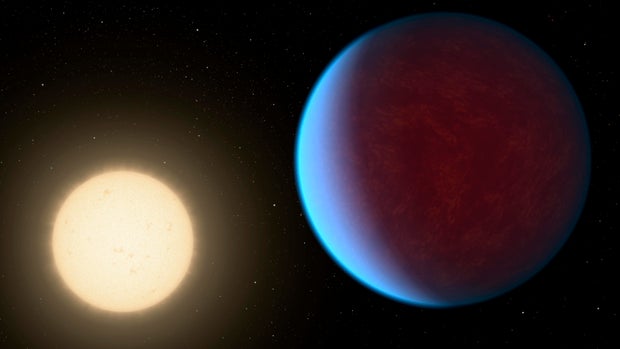A thick atmosphere has been detected around a planet that’s twice as big as Earth in a nearby solar system, researchers reported Wednesday.
The so-called super Earth — known as 55 Cancri e — is among the few rocky planets outside our solar system with a significant atmosphere, wrapped a blanket of carbon dioxide and carbon monoxide. The exact amounts are unclear. Earth’s atmosphere is a blend of nitrogen, oxygen, argon and other gases.
“It’s probably the firmest evidence yet that this planet has an atmosphere,” said Ian Crossfield, an astronomer at the University of Kansas who studies exoplanets and was not involved with the research.
The research was published in the journal Nature.
Super Earth refers to a planet’s size — bigger than Earth but smaller than Neptune. The boiling temperatures on this planet — which can reach as hot as 4,200 degrees Fahrenheit – mean that it is unlikely to host life.
NASA/JPL-Caltech via AP
Instead, scientists say the discovery is a promising sign that other such rocky planets with thick atmospheres could exist that may be more hospitable.
The exoplanet 41 light years away is eight times heavier than Earth and circles its star Copernicus so closely that it has permanent day and night sides. A light-year is nearly 6 trillion miles (9.7 trillion kilometers). Its surface is encrusted with magma oceans.
To identify the makeup of its atmosphere, researchers studied Webb Space Telescope observations before and after the planet passed behind its star.
They separated the light emitted from the planet versus its star and used the data to calculate the planet’s temperature. There’s evidence the planet’s heat was being distributed more evenly across its surface – a party trick atmospheres are known for.
Gases from its magma oceans may play a key role in holding its atmosphere steady. Exploring this super Earth may also yield clues to how Earth and Mars might have evolved first with magma oceans that have since cooled, scientists say.
“It’s a rare window,” said Renyu Hu, a planetary scientist at NASA’s Jet Propulsion Laboratory, who was part of the research. “We can look into this early phase of planet evolution.”
55 Cancri e isn’t the first super Earth planet that scientists have detected in recent years. An international team of scientists said in 2022 that they had found two such planets, just 100 light-years from Earth. Both planets circle a red dwarf star, and one, known as LP 890-9c, might even be habitable.
In August 2022, scientists from NASA discovered a super Earth that could be a “water world,” making it also a candidate to support life. Researchers have yet to confirm just how much water is on the planet, known as TOI-1452 b. NASA said at the time that the James Webb Space Telescope would be used to further study the planet.
“As soon as we can, we will book time on the Webb to observe this strange and wonderful world,” researcher René Doyon said at the time.


